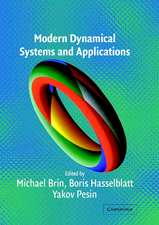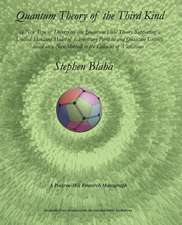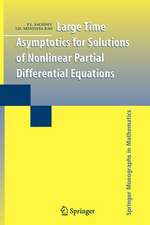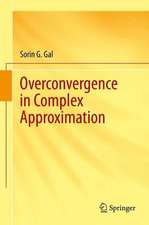An Introduction to Element-Based Galerkin Methods on Tensor-Product Bases: Analysis, Algorithms, and Applications: Texts in Computational Science and Engineering, cartea 24
Autor Francis X. Giraldoen Limba Engleză Paperback – noi 2021
| Toate formatele și edițiile | Preț | Express |
|---|---|---|
| Paperback (1) | 504.50 lei 6-8 săpt. | |
| Springer International Publishing – noi 2021 | 504.50 lei 6-8 săpt. | |
| Hardback (1) | 604.70 lei 6-8 săpt. | |
| Springer International Publishing – 31 oct 2020 | 604.70 lei 6-8 săpt. |
Din seria Texts in Computational Science and Engineering
-
 Preț: 400.26 lei
Preț: 400.26 lei - 19%
 Preț: 544.68 lei
Preț: 544.68 lei - 4%
 Preț: 466.32 lei
Preț: 466.32 lei - 20%
 Preț: 325.00 lei
Preț: 325.00 lei - 15%
 Preț: 595.86 lei
Preț: 595.86 lei - 20%
 Preț: 588.53 lei
Preț: 588.53 lei -
 Preț: 389.11 lei
Preț: 389.11 lei -
 Preț: 416.01 lei
Preț: 416.01 lei -
 Preț: 430.21 lei
Preț: 430.21 lei -
 Preț: 439.07 lei
Preț: 439.07 lei -
 Preț: 451.55 lei
Preț: 451.55 lei -
 Preț: 494.11 lei
Preț: 494.11 lei - 15%
 Preț: 608.08 lei
Preț: 608.08 lei -
 Preț: 394.87 lei
Preț: 394.87 lei -
 Preț: 396.10 lei
Preț: 396.10 lei -
 Preț: 387.75 lei
Preț: 387.75 lei -
 Preț: 396.62 lei
Preț: 396.62 lei -
 Preț: 482.45 lei
Preț: 482.45 lei - 20%
 Preț: 338.03 lei
Preț: 338.03 lei -
 Preț: 498.91 lei
Preț: 498.91 lei -
 Preț: 398.35 lei
Preț: 398.35 lei -
 Preț: 390.84 lei
Preț: 390.84 lei
Preț: 504.50 lei
Nou
Puncte Express: 757
Preț estimativ în valută:
96.54€ • 99.59$ • 80.56£
96.54€ • 99.59$ • 80.56£
Carte tipărită la comandă
Livrare economică 27 martie-10 aprilie
Preluare comenzi: 021 569.72.76
Specificații
ISBN-13: 9783030550714
ISBN-10: 3030550710
Pagini: 559
Ilustrații: XXVI, 559 p. 171 illus., 168 illus. in color.
Dimensiuni: 155 x 235 mm
Greutate: 0.81 kg
Ediția:1st ed. 2020
Editura: Springer International Publishing
Colecția Springer
Seria Texts in Computational Science and Engineering
Locul publicării:Cham, Switzerland
ISBN-10: 3030550710
Pagini: 559
Ilustrații: XXVI, 559 p. 171 illus., 168 illus. in color.
Dimensiuni: 155 x 235 mm
Greutate: 0.81 kg
Ediția:1st ed. 2020
Editura: Springer International Publishing
Colecția Springer
Seria Texts in Computational Science and Engineering
Locul publicării:Cham, Switzerland
Cuprins
Introduction.- Motivation and Background.- Overview of Existing Methods.- One-Dimensional Problems.- Interpolation in One Dimension.- Numerical Integration in One Dimension.- 1D Continuous Galerkin Method for Hyperbolic Equations.- 1D Discontinuous Galerkin Methods for Hyperbolic Equations.- 1D Unified Continuous and Discontinuous Galerkin Methods for
Systems of Hyperbolic Equations.- 1D Continuous Galerkin Methods for Elliptic Equations.- 1D Discontinuous Galerkin Methods for Elliptic Equations.- Two-Dimensional Problems.- Interpolation in Multiple Dimensions.- Numerical Integration in Multiple Dimensions.- 2D Continuous Galerkin Methods for Elliptic Equations.- 2D Discontinuous Galerkin Methods for Elliptic Equations.- 2D Unified Continuous and Discontinuous Galerkin Methods for Elliptic Equations.- 2D Continuous Galerkin Methods for Hyperbolic Equations.- 2D Discontinuous Galerkin Methods for Hyperbolic Equations.- 2D Continuous/Discontinuous Galerkin Methods for Hyperbolic Equations.- Advanced Topics.- Stabilization of High-Order Methods.- Adaptive Mesh Refinement.- Time Integration.- 1D Hybridizable Discontinuous Galerkin Method.- Classification of Partial Differential Equations and Vector Notation.- Jacobi Polynomials.- Data Structures.
Systems of Hyperbolic Equations.- 1D Continuous Galerkin Methods for Elliptic Equations.- 1D Discontinuous Galerkin Methods for Elliptic Equations.- Two-Dimensional Problems.- Interpolation in Multiple Dimensions.- Numerical Integration in Multiple Dimensions.- 2D Continuous Galerkin Methods for Elliptic Equations.- 2D Discontinuous Galerkin Methods for Elliptic Equations.- 2D Unified Continuous and Discontinuous Galerkin Methods for Elliptic Equations.- 2D Continuous Galerkin Methods for Hyperbolic Equations.- 2D Discontinuous Galerkin Methods for Hyperbolic Equations.- 2D Continuous/Discontinuous Galerkin Methods for Hyperbolic Equations.- Advanced Topics.- Stabilization of High-Order Methods.- Adaptive Mesh Refinement.- Time Integration.- 1D Hybridizable Discontinuous Galerkin Method.- Classification of Partial Differential Equations and Vector Notation.- Jacobi Polynomials.- Data Structures.
Notă biografică
Francis (Frank) Giraldo is a Distinguished Professor of Applied Mathematics at the Naval Postgraduate School and a founding member of the Scientific Computing group. He and his team built the NUMA model using the element-based Galerkin (EBG) methods described in this text; NUMA is a Navier-Stokes solver used for atmospheric, ocean, and fluid dynamics simulations. Frank Giraldo (and colleagues) hosted the 2012 Gene Golub SIAM Summer School on Simulation and Supercomputing in the Geosciences where EBG methods was one of the topics of the summer course. In addition, Frank has served on the National Earth Systems Prediction Capability working groups for over 10 years, and has served on the Department of Energy’s INCITE panels for over 5 years (including chairing the committee a number of times).
Textul de pe ultima copertă
This book introduces the reader to solving partial differential equations (PDEs) numerically using element-based Galerkin methods. Although it draws on a solid theoretical foundation (e.g. the theory of interpolation, numerical integration, and function spaces), the book’s main focus is on how to build the method, what the resulting matrices look like, and how to write algorithms for coding Galerkin methods. In addition, the spotlight is on tensor-product bases, which means that only line elements (in one dimension), quadrilateral elements (in two dimensions), and cubes (in three dimensions) are considered. The types of Galerkin methods covered are: continuous Galerkin methods (i.e., finite/spectral elements), discontinuous Galerkin methods, and hybridized discontinuous Galerkin methods using both nodal and modal basis functions. In addition, examples are included (which can also serve as student projects) for solving hyperbolic and elliptic partial differential equations,including both scalar PDEs and systems of equations.
Caracteristici
The construction of element matrices and the resulting matrices are shown for all the differential operators discussed. This helps the reader understand the material clearly and assists them in building their numerical algorithms Both modal and nodal basis functions are discussed throughout the text, including examples for the continuous and discontinuous Galerkin method, it is shown how to combine both of these methods into one piece of code; moreover, a description of hybridized discontinuous Galerkin method is included in this textbook. A sample solution along with the order of accuracy and time-to-solution (work-precision diagrams) are shown for a variety of test problems for different types of equations (e.g., hyperbolic and elliptic) Sample code for student projects are provided on my Github page with code in both matlab and Julia (see https://github.com/fxgiraldo/Element-based-Galerkin-Methods)
















